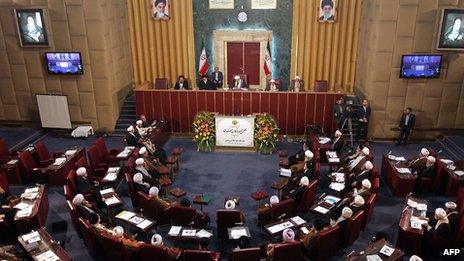Why Iran's watchdogs hold no fear for Supreme Leader
- Published

Iran's Assembly of Experts - ostensibly one of the most powerful institutions in the Islamic Republic - is holding its biannual session in Tehran.
The body has the authority to appoint and remove the country's Supreme Leader - a prospect which would naturally lead one to expect to see the Supreme Leader defending his policies before assembly members as they assess his performance on every state-related issue that he is responsible for - which is just about everything.
In reality, the functions and membership of the assembly are largely irrelevant to Iranian politics and the members are far from being vigilant, critical monitors of the Supreme Leader.
There are 86 clerics in the assembly, most of them very old.
Twice a year, they take a few days off from other activities to convene as the top body.
Some of them are the Supreme Leader's provincial representatives (appointees), some are only seminarians and some hold governmental positions.
The opening ceremony and the public speeches are always lead stories in the state-run media.
However, the purpose of holding these sessions, other than making an appearance, is not clear.
The assembly's job description is Herculean, but its workload, in practice, minuscule.
According to Iran's constitution, the Assembly of Experts has the task of choosing a Supreme Leader if one dies or is deposed.
They have done this just once - when they convened immediately after the death of Ayatollah Ruhollah Khomeini to choose Ayatollah Ali Khamenei as his successor in 1989.
Their second duty is to oversee the Supreme Leader's performance and depose him if he "fails to fulfil his duties".
This sounds like a very important job given that the Supreme Leader is not only legally the "absolute" ruler, with the final say on all state matters, but also appoints the heads of some of the most powerful authorities in Iran.
These include: the commander of the Revolutionary Guards, the head of state TV and radio, the head of the judiciary, and the heads of numerous semi-official and wealthy religious foundations - to mention but a few.
'Chosen by the people'
Advocates of the Iranian regime are quick to point out that the Supreme Leader is chosen by the people because the Assembly of Experts is chosen by the people. The latter part of this proposition is true. The election for the Assembly of Experts is held every eight years.
The idea of having an Assembly of the Leader's Experts came in the early days of the 1979 revolution, when the authors of the new constitution presented their own version of a checks-and-balances mechanism in order to show that the Supreme Leader was not exempted from accountability.
The first Supreme Leader was too revered to be even mildly criticised, let alone held accountable.
His successor managed to transform the assembly into one that protects him from accountability rather than subject him to it.
Not only are some members of the Assembly of Experts appointees of the Supreme Leader in other institutions, but his appointees in one particularly powerful institution - the Guardian Council - also decide who can become a candidate in the election for the Assembly.
The end result has been a seemingly idle body of clerics who do little more than rubber-stamp the Supreme Leader's policies and edicts.
Those clerics among them who are more influential and respected - the "jurisprudents" - go to various lengths to explain why the Supreme Leader ought to be obeyed rather than checked.
Ayatollah Mesbah Yazdi's argument in one of his writings is remarkable: "The harm of disobeying and questioning a military commander pales in comparison to the harm of obeying his wrong decisions because disobedience gives rise to chaos and one does not disobey leaders over the possibility of their making a mistake."
He has also recently characterised the Supreme Leader as "semi-infallible".
The Supreme Leader himself has also weighed in on the discussion, asserting of his office that "should the leader fail to fulfil his duties, he will automatically lose his credentials".
Few critics
Infiltrating the Assembly of Experts was a priority for Iranian reformers in the 1990s.
They hoped that once they got in, they could begin to highlight the failings of the Supreme Leader in his choices and performances. They were all barred from running.
There are currently fewer than five members who can remotely be considered critics in the assembly, including former President Hashemi Rafsanjani - and even he was marginalised by his colleagues last year when he lost the Speaker's chair.
When the assembly convenes, it does so mostly behind closed doors. The public is not missing anything because as far as we know as nothing important has ever been said in these sessions.
The statements that do come out of the assembly are as predictable as its agenda. The main agenda for the current session is to select a five-member committee who will draft the closing statement.
The language and tone of these statements, particularly praising of the Supreme Leader, have not changed over the years.
However, what distinguishes one statement from another are their references to current events that reiterate Iran's official line on the domestic and foreign issues of the day.
The three-day session traditionally ends with a visit to the shrine of the previous Supreme Leader, and reporting to the current one.